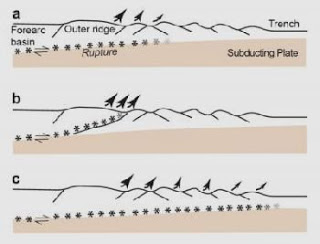
Instead of the usual weak, loose sediments typically found above the type of geologic fault that caused the earthquake, the team found a thick plateau of hard, compacted sediments. Once the fault snapped, the rupture was able to spread from tens of kilometers below the seafloor to just a few kilometers below the seafloor, much farther than weak sediments would have permitted. The extra distance allowed it to move a larger column of seawater above it, unleashing much larger tsunami waves.
“The results suggest we should be concerned about locations with large thicknesses of sediments in the trench, especially those which have built marginal plateaus,” said Sean Gulick, research scientist at The University of Texas at Austin’s Institute for Geophysics. “These may promote more seaward rupture during great earthquakes and a more significant tsunami.”
The team’s results appear this week in an article lead-authored by Gulick in an advance online publication of the journal Nature Geoscience.
The team from The University of Texas at Austin, The University of Southampton in the United Kingdom, The Agency for the Assessment and Application of Technology in Indonesia and The Indonesia Institute for Sciences used seismic instruments, which emit sound waves, to visualize subsurface structures.
The earthquake struck along a fault where the Indo-Australian plate is being pushed beneath the Sunda plate to the east. This is known as a subduction zone and in this case the plates meet at the Sunda Trench, around 300km west of Sumatra. The Indo-Australian plate normally moves slowly under the Sunda plate, but when the rupture occurred, it violently surged forward.
Subduction earthquakes are thought to start tens of kilometers beneath the Earth’s surface. Displacement or “slip” on the fault, as geologists call it, propagates upwards and generally dissipates as it reaches weaker rocks closer to the surface. If it were an ordinary seismic zone, the sediment in the Sunda Trench should have slowed the upward and westward journey of the 2004 earthquake, generating a tsunami in the shallower water on the landward (east) side of the trench.
But in fact the fault slip seems to have reached close to the trench, lifting large sections of the seabed in deeper water and producing a much larger tsunami.










